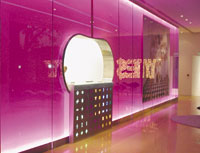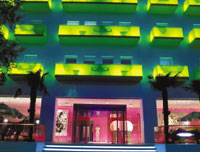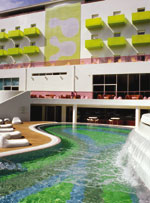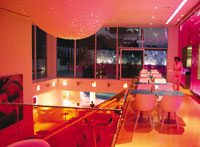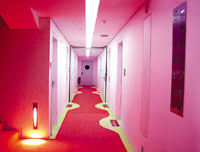旅馆照明设计案例
Colored glass and light combine to create a juicy hotel experience at the Semiramis in Athens, Greece.
»The Olympics may be over, but the host city of Athens has some wonderful architecture (an updated sports stadium by Santiago Calatrava, for example) as a result—and at least one very cool hotel. With interiors designed by Karim Rashid and a lively lighting concept crafted by New York City firm Focus Lighting, the 52-room Semiramis, which opened for the Olympics last summer, seems to make a stronger statement than even gathering 202 countries and 11,000 athletes together in one city did. The message: fun, fun, fun.
Much of the boutique hotel's impact has to do with the juicy colors that seem to flow over and beyond the structural boundaries—through balconies, out the front entrance, up and down walls, and across the ceiling plane. This effect is a result of light's interaction with the colored glass that exists throughout. The most apparent example of their communion is the four stories of balconies visible from the exterior. Wrapped with green-tinted glass, the guest-room lookouts interact playfully with sunlight during the day; at night, backlit by 9W fluorescent steplights located on either side of the balcony door, the lemony silhouette of the table and chairs suggest the trendy hospitality inside.
Backlit with blue-gel fluorescents, the fritted-glass floor that feeds visitors into the lobby continues the project's colorful alliance of glass and light. Around the white cutout of the reception desk, a lightly frosted glass wall—up and downlighted with LEDs—slowly rotates through a color cycle, as do LED-illuminated ceiling slots that stretch across the lobby. "These are soft, beautiful colors," says Paul Gregory, principal designer. "They are the colors of sunset when the sun is coming through at a low angle and everyone has a warm, rich glow. People look good because of all the pink." Indeed, under Rashid's direction, pink became the color of choice throughout the space, such as in the second-floor lounge area where a rose-tinted glass wall faces an amber glass railing. Even the cantilevered bedside tables are fabricated from pink glass. "Karim wanted to be sure that pink would be the overriding factor, which I didn't agree with immediately—I thought it would be too pink—but it worked," says Gregory, who notes that the filter is mild enough that blues and lavenders can come through. "We can get anything with a little red in it."
Quirky details, brought to the fore with light, contribute to the Semiramis's unique character. Each guest room in the hotel has its own symbol, rather than a room number; these appear as backlit glass cutouts at the front desk. If a guest has a message, the symbol corresponding to his or her room will light up. Communication is taken to a new level, not just here but throughout the hotel. Hanging paper "do not disturb" signs are rendered obsolete by LED "message boards" on the floor in front of each guest room, which tie back into and deliver the guests' wish list to a central switchboard. Wayfinding was also considered in the design, and again interpreted specifically with light. Each of the four floors has a dedicated color—lime, pink, orange, and white—which the designers incorporated by backlighting colored acrylic lenses, which are recessed in the ceiling, with white LEDs. (Unlike the lobby, the colored lighting effect in the hallways is static. The slot in the ceiling plane was originally intended to not only light the hallway, but to actually lead guests to their rooms. The keycard would trigger a sensor in the luminaire that would then light the distance to the guest's room. While this element was cut for budgetary reasons, the wiring is in place, should the hotel want to implement the idea.
The lighting design at Semiramis is obviously inclined toward LEDs, but this is because the technology was "right" for the reality of the project. "The LED presence is strong, but not just for the purpose of having LEDs," says Gregory. "We didn't have a lot of room in the ceiling, for example, so what could we put up there that would fit in under 2 inches and provide an even, glowing band? With fluorescent, we wouldn't be able to get our fingers in the slot to remove the lamp and there would be a socket shadow." Where LEDs are used in the lobby, it became a question of maintenance, since the color-changing luminaires would be sealed into the wall—a scenario familiar to the designer from his work on Morimoto restaurant in Philadelphia. "We sealed in the LEDs at Morimoto," says Gregory. "It has been four years and they still work great." emilie w. sommerhoff
DETAILS
project Semiramis Hotel, Athens
interior designer Karim Rashid Inc., New York City
lighting designer Focus Lighting, New York City
photographer Jennifer Alexander/Focus Lighting, and Jean Francois Jassid
manufacturers FiberPro Solutions (custom lighting; fiber optic installation; single and color-changing LEDs); Ghidini Neo; Unilamp
凡本网注明“来源:阿拉丁照明网”的所有作品,版权均属于阿拉丁照明网,转载请注明。
凡注明为其它来源的信息,均转载自其它媒体,转载目的在于传递更多信息,并不代表本网赞同其观点及对其真实性负责。
